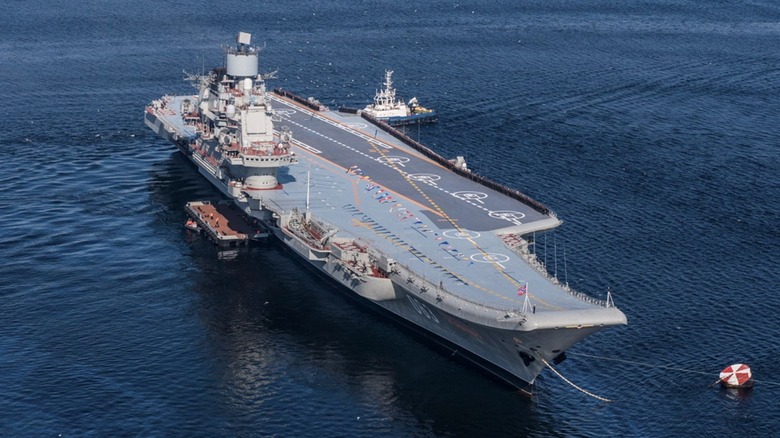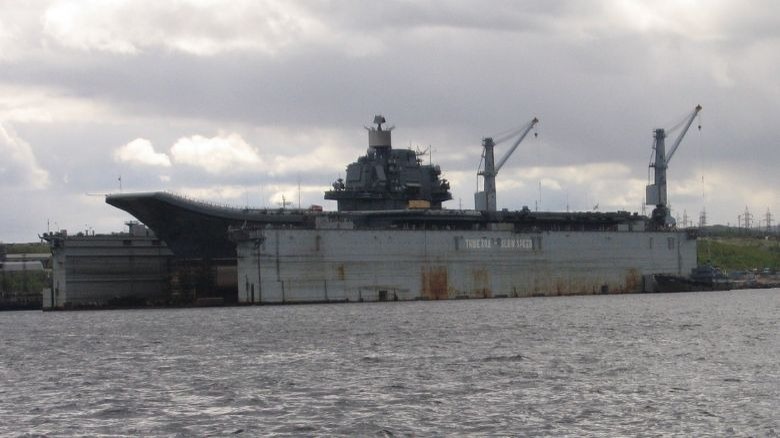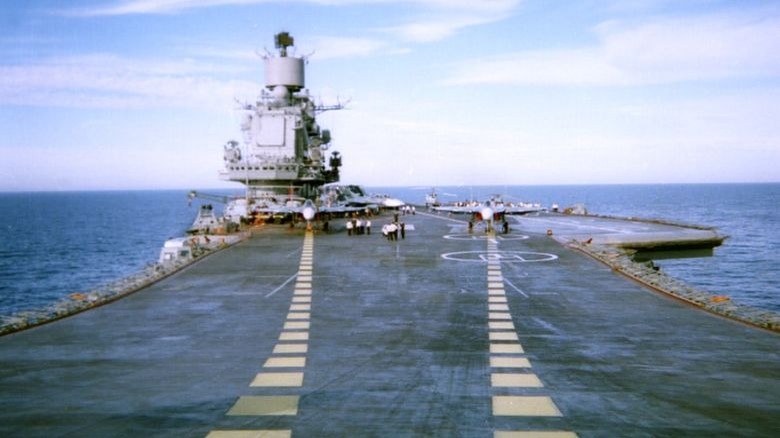Admiral Kuznetsov: Everything You Need To Know About Russia's Only Aircraft Carrier
The United States may have fought an entire front of World War II with aircraft carriers, but the oversized vessels weren't even a thought for the Russia's navy at the time. Rather, it waited until 1975 to launch its first aircraft carrier, the Kiev, though it had two Moskva-class helicopter carriers in its employ since 1967. Since launching the Kiev, Russia produced a relatively small fleet of Kiev, Moskva, Ulyanovsk, and Admiral Kuznetsov-class carriers, spanning only seven traditional aircraft carriers.
While it wasn't the smallest fleet of aircraft carriers (that honor belongs to Germany and its fleet of seven that was never completed), Russia is about to become one of the smallest as its last remaining carrier, the Admiral Kuznetsov, falls into disrepair. The youngest carrier in the fleet, the Admiral Kuznetsov (technically named Admiral Flota Sovetskogo Soyuza Kuznetsov), temporarily ceased operations in 2017 for repairs, with an expected relaunch sometime near the end of 2024. However, as issues continue to arise, it's quite possible the unluckiest craft in Russia's navy may be decommissioned for good, putting an end to one of the more interesting vessels of the nation's fleet.
[Image by Сергей Федюнин via Wikimedia Commons | Cropped and scaled | CC BY-SA 4.0]
Who was Admiral Kuznetsov?
Much like the United States' Nimitz-class aircraft carriers, the Admiral Kuznetsov-class Russian alternative was named for a Soviet admiral. Nikolai Kuznetsov was born to Serbian peasants. At 15 years old, he lied to the Soviet navy, claiming he was 17, so he could enlist with the Northern Dvina Naval Flotilla. Throughout his military career, Kuznetsov served aboard the Chervona Ukraina and Krasnyi Kavkaz cruisers, eventually earning a spot as the commander of the former in 1934, two years before the outbreak of the Spanish Civil War. During, he served as an advisor to Spain, earning him the title of commander of the Soviet Union's Pacific Fleet upon his return.
World War II proved difficult for Kuznetsov, who served as the Navy's commissar. The Soviet Navy failed to impress during the conflict, though Kuznetsov passed the blame to the navy's former political commissar and earned himself the titles Hero of the Soviet Union and Marshal of the Soviet Union. Joseph Stalin accused him of being a traitor and he was demoted — a decision that would later be overturned as he returned as Pacific Fleet commander. Despite being wholly blamed for the 1955 explosion of the Novorossisk in Sevastopol that claimed 603 lives and forced to retire, Kuznetsov's image was later saved by his widow in 1988, six years after the first Admiral Kuznetsov-class carrier was commissioned.
[Image by Mikhail Rogov via Wikimedia Commons | Cropped and scaled | CC BY-SA 4.0]
It almost belonged to Ukraine
Though Admiral Kuznetsov is currently under Russian control, in the early '90s, it almost became part of Ukraine's Navy. After Ukraine gained independence from Russia in November 1991, the carrier was left in Ukrainian waters following a series of tests as part of the Black Sea Fleet in Feodosia. Ukraine had every intention of absorbing Admiral Kuznetsov into its navy, with Ukrainian President Leonid Kravchuk even demanding that it be kept in Sevastopol.
Regardless of Ukraine's wishes, Russia wasn't about to leave its carrier in the hands of another government. Within a month of Kravchuk's direct command, the Russians silently reclaimed the carrier. Russia's Northern Fleet deputy commander arrived in Ukraine to pull off the maneuver. Without Ukraine knowing, the ship sailed out of its territory with a reduced crew, navigation lights off to keep from alerting any nearby personnel. The aircraft carrier made it to Russian waters safely and has since remained the property of the Russian Navy.
It's a cursed carrier
According to the U.S. Naval Institute, the Russian carrier hasn't had the most active service history — at least, not one that includes a lot of time being a functional part of the country's Navy. It's estimated that Kuznetsov spent around 15 days per year in active deployment, spending much time in the Atlantic and Mediterranean. The final deployment in 2016 was symbolic of her service, as two aircraft crashed during an attempted landing. By 2017, the Kuznetsov was pulled from service and scheduled for repairs that may never be finished.
Though the Russian Navy has every intent of fixing the carrier and returning it to sea, there's been no such luck. In 2018, a crane collapsed onto her deck during an overhaul in Kola Bay. Though the floating dock began to sink, the Kuznetsov was rescued and suffered minimal damage. During the following year, her engine room caught fire after a welding accident, resulting in two deaths and 14 injuries. That incident was followed by a power outage and damage to the drydock, which further delayed repairs.
As of July 2023, Russia's news agency, TASS, confirmed the ship was planning to enter into sea trials by spring 2024. As of June 2024, there has been no update, and, as Russia is engaged with Ukraine in an ongoing conflict, it's possible it won't return to service anytime soon.
Admiral Kuznetsov vs. the USS Gerald R. Ford
As the pride of the U.S. Navy's carrier fleet, the USS Gerald R. Ford should outclass the outdated and rather ill-fated Kuznetsov. Requiring over 4,500 crewmembers, including aircrew and staff, one thing is certain — the Gerald R. Ford is definitely more demanding than Russia's carrier, which requires a crew of just over 1,600 and an air group. But the Gerald R. Ford also has a greater show of force, with a capacity of 75 aircraft compared to the Admiral Kuznetsov's maximum of 40.
Overall, the U.S. carrier is larger, faster, and newer than Russia's, allowing it to be equipped with new and more efficient technology. The Russian carrier uses an outdated bow (or ski jump) ramp, which significantly limits the size of aircraft it can launch. In fact, during its one combat deployment, the Kuznetsov's ramp failed, resulting in the loss of two airframes. Conversely, the Gerald R. Ford uses an electromagnetic aircraft launch system (EMALS), which maximizes the efficiency, reliability, and accuracy of every launch.
[Image by Public Domain via Wikimedia Commons | Cropped and scaled | CC BY-SA 4.0]




